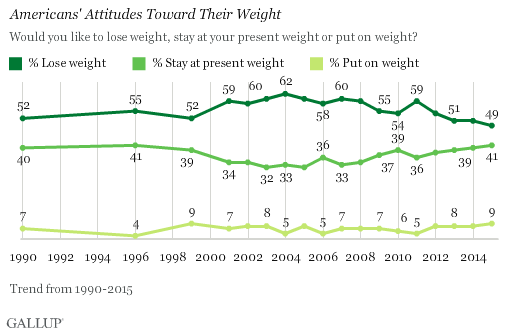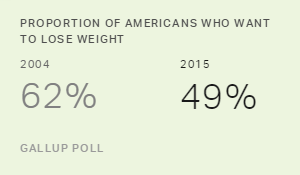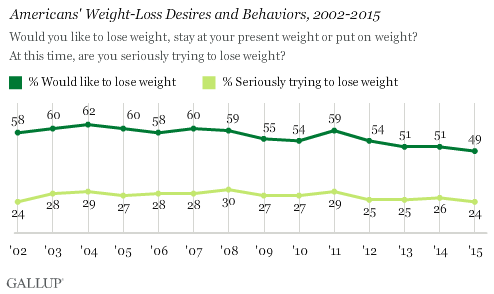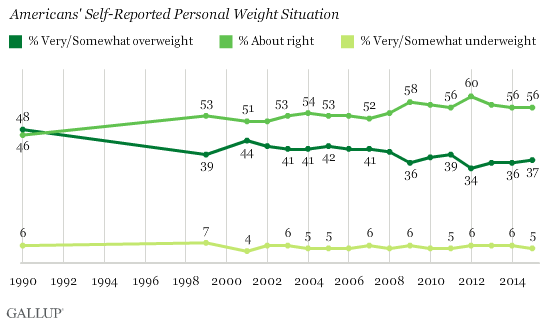STORY HIGHLIGHTS
- Forty-one percent would like to stay at current weight
- Fewer than one in four “seriously trying” to drop pounds
- Americans twice as likely to want to lose weight as to be seriously trying
WASHINGTON, D.C. — As Americans enjoy Thanksgiving leftovers this year, about half (49%) say they would like to lose weight. This is down from readings near 60% from 2001 to 2008.
The latest update of Gallup’s annual Health and Healthcare poll, conducted Nov. 4-8, finds that for the first time in at least 25 years, less than half of Americans want to lose weight. Gallup polls from the 1950s found that only about a third of Americans wanted to lose weight.
Along with the decrease in the percentage of Americans wanting to lose weight in recent years, there has been an accompanying increase in the proportion who say they would like to stay at their present weight — currently 41%. About one in 10 adults (9%) say they would like to put onweight.
As part of the Gallup-Sharecare Well-Being Index, Gallup calculates Americans’ body mass index scores based on respondents’ self-reported height and weight. The obesity rate ticked up to 27.7% in 2014, the highest rate recorded since Gallup and Sharecare began tracking it in 2008. Still, Americans’ desire to lose weight has not increased.
In addition to being less likely to say they want to lose weight in recent years, fewer Americans say they are making a concerted effort to do this. Less than a quarter of adults (24%) report they are “seriously trying to lose weight.” This is the lowest reading since 2002, though it is similar to the 25% to 30% of adults who said they were “seriously” trying from 2003 through 2014.
Americans Have Become Less Likely to Say They Are Overweight Since 1990
When asked to describe their weight, 37% say they are “very” or “somewhat overweight.” This has generally declined since 1990, when about half of adults (48%) said they were overweight. Meanwhile, 5% say they are “very” or “somewhat underweight.”
Americans, however, are most likely to describe their weight as “about right” (56%) — consistent with readings since 2009. From 1990 to 2008, this figure was in a lower range, from 46% to 54%.
The overwhelming majority of those who say they are overweight also report wanting to lose weight. Over the past decade, between 90% and 96% of those who describe themselves as overweight have said they wanted to drop some pounds. This suggests that the decline in the percentage of Americans wanting to lose weight is more attributable to fewer people saying they are overweight than to overweight people being less likely to say they want to lose weight.
Bottom Line
Obesity in the United States has become a greater concern in the medical community and in society at large. In recent years, Gallup and Sharecare have documented a slight but notable increase in the percentage of Americans who can be classified as obese, based on BMI calculations that use self-reports of height and weight. And obesity has ranked near the top of the list when Americans are asked to name the most urgent health problem facing the U.S.
Even so, the percentage of Americans who want to lose weight has dipped below the 50% mark for the first time in at least two decades, and a solid majority continue to say their weight is “about right.” It is unclear whether those self-assessments are based on Americans’ success in losing weight, or on a change in their thinking about what constitutes a healthy weight. Americans who are slightly above a normal weight, by BMI standards, may think of themselves as being “about right” and not urgently needing to lose weight.
Historical data are available in Gallup Analytics.
SURVEY METHODS
Results for this Gallup poll are based on telephone interviews conducted Nov. 4-8, 2015, with a random sample of 1,021 adults, aged 18 and older, living in all 50 U.S. states and the District of Columbia. For results based on the total sample of national adults, the margin of sampling error is ±4 percentage points at the 95% confidence level. All reported margins of sampling error include computed design effects for weighting.
Each sample of national adults includes a minimum quota of 60% cellphone respondents and 40% landline respondents, with additional minimum quotas by time zone within region. Landline and cellular telephone numbers are selected using random-digit-dial methods.
Learn more about how Gallup Poll Social Series works.



